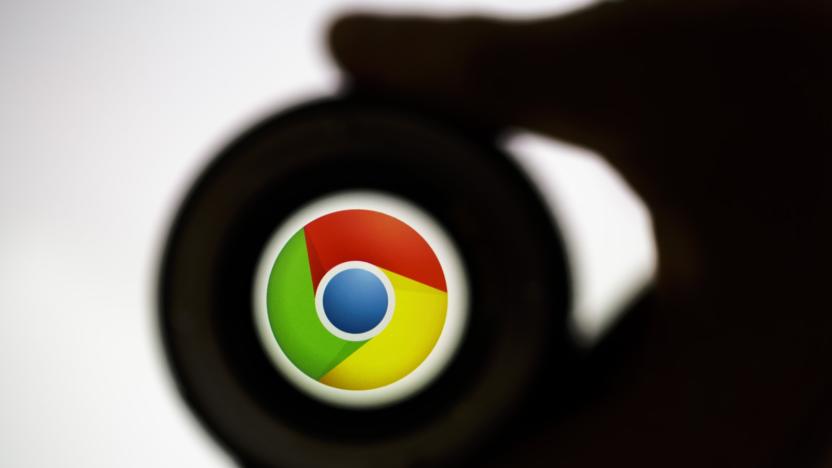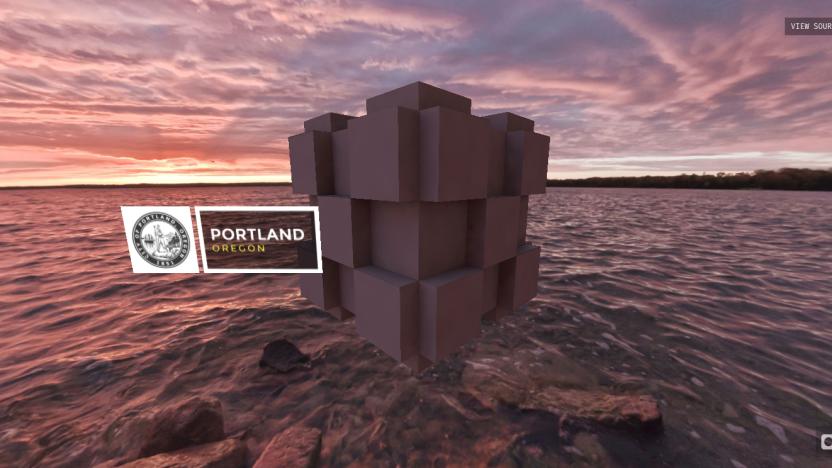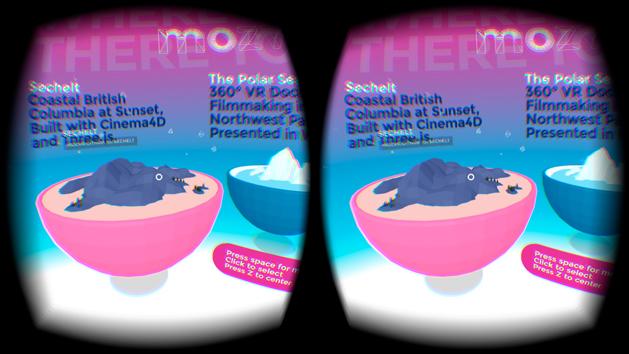webgl
Latest

Chrome quietly received a big 3D graphics boost
Did you recently notice a boost to 3D web graphics while using Chrome? It's not just you. Google has revealed that Chrome 56 and later releases support the WebGL 2.0 standard. You should see faster performance, new texture types and visual effects (such as volume-based effects and tone mapping). And importantly, it's now on par with the same OpenGL ES 3 spec you see in newer mobile games -- it might now be possible to port your favorite phone title to Chrome without losing graphical detail.

Mozilla makes it easy to create VR websites with 'A-Frame'
With the launch of A-Frame today, Mozilla is trying to make it easier for developers to craft virtual-reality websites. Mozilla's VR research team, MozVR, created A-Frame as an open-source framework that allows developers to use familiar HTML markup in their designs, rather than the complex WebGL API. A-Frame operates within WebGL, meaning it works across desktop, iPhones, all Cardboard devices and Oculus Rift Dev Kit 2 headsets, with Android support "coming soon." It'll eventually support additional VR devices, such as HTC's Vive.

Chrome's 1,000th web experiment visualizes all the others
Google has offered a ton of Chrome Experiments to show what modern web technology can do, but it's doing something special for the 1,000th project -- namely, visualizing all the other projects. The effort lets you browse six years' worth of browser-based art, games and other creative works in multiple ways, including a tag-based timeline and a live code editor. To top things off, Google has redesigned the Experiments site so that it scales properly on everything from phones to desktops. You probably won't have time to explore every single web snippet, but it's worth a visit to number 1,000 if you're wondering what you've missed.

Chrome experiment turns Wikipedia into a virtual galaxy
There's no denying Wikipedia's usefulness, but French computer science student Owen Cornec believes the website could stand to display entries "in a more engaging way." Thus, he created WikiGalaxy: a special Wikipedia browser that visualizes the website as a 3D galaxy. Each star represents an article, and related entries form clusters of stars -- clicking a star loads the entry itself on the left-hand panel and links to relevant articles on the right. If you want to make browsing Wiki even more interactive, you can activate "fly-mode," which sends you zooming through the stars with each click. It's a really fun way to discover new articles, and you have to try it out if you can.

Mozilla's new site brings virtual reality to the web
As you might imagine, most websites aren't designed for virtual reality; bob your head around and you'll only look silly. Mozilla clearly isn't happy with that lack of immersion, as it just launched MozVR.com to foster VR-native sites. The page lets Oculus Rift owners browse technology demos (in a Rift-friendly interface, naturally) that show off what VR can do on the web, such as a flyover of British Columbia or a 360-degree documentary. And if you want to build one of these experiences yourself, you'll get a helping hand -- Mozilla is sharing the code, tools and tutorials for its own front end. It'll probably be a long, long while (if ever) before you're regularly surfing the web with goggles on, but this may get the ball rolling.

Play with Quake and Doom in mobile Safari thanks to iOS 8 and WebGL
One overlooked but exciting part of iOS 8 is the new WebGL support added to mobile Safari. WebGL allows the Safari browser to harness the power of the phone's GPU using HTML 5 and Javascript. Now with iOS 8, iPhone and iPad owners can render 3D WebGL content in their browser, including these awesome online demos of Quake III and Doom III models from Google WebGL developer Brandon Jones. Check them out on your iOS 8 device and let us know what you think in the comments. [Via TouchArcade]

New plugin-free web games run (almost) as well as their desktop counterparts
So far, sophisticated 3D web games have typically required either a plugin (think Quake Live) or a special environment where they can run native code. While those are just dandy, they aren't really web games, are they? That's going to change shortly, as Trendy Entertainment has revealed plans to launch truly web-based versions of both Dungeon Defenders Eternity and the upcoming Dungeon Defenders II. Both Unreal Engine-based titles use a mix of open standards like WebGL, Web Audio and Mozilla's heavily tuned JavaScript web code (asm.js) to handle desktop-level 3D and sound in your browser at "near native" speeds. You may not notice the difference at all, provided you're on a reasonably quick PC.

Unity 5 game engine brings advanced lighting, physics and audio effects to mobile, PC and now the web
At the Game Developers Conference, or for those in the know: GDC, we got a taste of the new Unity 5 game engine. For most of you, a new engine doesn't mean much, but in the hands of the right people, it can mean more beautiful and realistic games. Unity, which powers any number popular titles, especially on the mobile front, is getting a host of new features for version five. Most notably is a new physics-based shader system and integration of Geomerics Enlighten illumination tools -- that means more realistic lighting and shadows as well as console-caliber visual effects. The engine's audio pipeline has also been rebuilt from the ground up for better performance and more flexibility when it comes to mixing sound and adding effects. But perhaps the biggest addition is early access to WebGL support, which means you'll be able to build titles that work on iOS, Android, Blackberry, Windows Phone, OS X, Windows, Linux, PlayStation, Xbox, WiiU and any modern web browser. As an example, Unity will be demoing Dead Trigger 2 running on WebGL at their booth at GDC.

Build anything you want with Legos, in Chrome
Let's be honest: You're never too old to play with Legos. Thanks to the latest Chrome experiment (and a little help from WebGL) you can build whatever your heart desires directly from your browser. Using Maps, you're able to choose a location-specific plot before starting to build, brick by brick. As you might expect, creations can be viewed across Google+ circles with categories for sorting, and tutorials will help hone those plastic contractor skills. If you really wanna get hands-on, use your phone or tablet's touchscreen for a more tactile feel. Itching to get started? You can begin construction right here.

Arcade Fire's 'Just a Reflektor' music video takes cues from your smartphone
Arcade Fire already knows how to immerse its fans in a web music video. For its new "Just a Reflektor" video, though, it's also bringing smartphones into the action. The band's Chrome-based project links a PC to a mobile device through a webcam, turning the handheld into a visual effects controller -- halos, reflections and wireframes in the video adapt to every movement. As the experiment is open source, viewers can even tinker with the web code (primarily JavaScript and WebGL) to build their own masterworks. Whether or not you're a fan of Arcade Fire's indie rock, you'll likely want to give "Reflektor" a look for curiosity's sake; just don't be surprised when the video looks back.

Chrome 30 beta adds quicker access to search by image, improved gestures and much, much more
The Chrome 30 beta has one of the longer lists of new features we've seen from the browser in quite some time. One of the most immediately visible will be a new option to search by image when you right-click or long-press on one. It'll use your default search provider to perform the task, but chances are you'll be using Google's own top-notch photo-mining service. The Android edition is also revamping its various gestures to make them easier to perform and lessen the chance of accidentally triggering them. Now all the gestures are performed in the top tool bar: swipe left or right to switch tabs, down from the middle to initiate the tab selector or down from the upper right-hand corner to open the menu. As if that wasn't enough, the back-end tech is getting a slew of new features on both the desktop and mobile sides. The Android version of the Chrome beta now supports WebGL, the MediaSource API and DeviceMotion, for making use of the accelerometer in the browser. MediaSource is particularly useful for generating dynamic streams of content that can adjust bit-rates on the fly, based on the quality of the connection. On the desktop, a load of new APIs have been added to the Chrome App framework, including support for in-app payments and downloads. WebRTC and speech recognition have also received improvements across all platforms. You can find out more details at the source and download the new Chrome beta at the more coverage links below.

Internet Explorer 11 to support WebGL and MPEG Dash
Few would say that consistency is good for its own sake. Microsoft certainly agrees -- it just revealed at Build that Internet Explorer 11 will reverse the company's previously cautious stance on WebGL. The new browser will support the 3D standard from the get-go, joining the likes of Chrome and Firefox. IE11 should improve plain old 2D as well, as there's hardware acceleration for video streaming through MPEG Dash. All told, Internet Explorer should be a better web citizen -- and deliver a speed boost in the process.

Google Mine service reportedly leaked, lets Google+ friends share real goods
Google is big on sharing all things virtual, but it hasn't done a lot to spread the wealth in the physical world. That could change soon: Google Operating System claims to have spotted an in-development Google Mine service that can simplify lending tangible goods. Users can list what they're sharing, offer items to their Google+ circles and keep track of who has what. The web version can reportedly show a collection in 3D through a WebGL viewer named Katamari, and there's also an Android app in tow. The feature set sounds ideal for generous Google+ users; the real question is whether we'll get to use any of it. Mine is supposedly limited to internal testing for now, and only some of Google's initiatives ever leave its campus. Google hasn't confirmed the effort, but the company tells us that it's "always experimenting" with features and doesn't have anything to share "at this time." Connected borrowers will just have to be patient, then -- assuming the service launches at all.

Chrome beta for Android exposes WebGL, brings more 3D to the mobile web
Did you hop on the new Chrome beta track for Android? There's a treat waiting under the hood. Google's Brandon Jones has confirmed that the latest build enables the flags page, letting us toggle hidden elements -- including the rather big deal of WebGL support. Anyone with reasonably quick graphics can now experiment with full 3D on their phone without having to hack or use a plugin, whether it's wild music videos or lovefests. Just remember that the experience won't be as seamless as it is on the desktop. You'll likely have to force the desktop version of a page just to see the graphics code, and few if any WebGL developers are optimizing for the performance and screen size of a phone. If you'd still like to get a peek at what could be the future of the mobile web, hit the source to join the beta flock.

Google MapsGL updates 3D buildings, improves virtual tourism
Google's been spending some quality time with its Maps offering of late. Most recently, it overhauled the 3D buildings and landmarks to make them, well, better. This time, its Maps' juiced up sibling MapsGL that's been feeling the paternal love. The WebGL-based 3D renderings have been the same treatment, making your virtual aerial tours all the more realistic. Now, as you glide over the landscape, your view of the buildings is much more like real life. Or you could just take the lazy tourism one step further. Hit the source for examples.

Love and Hate tweets collected on 3D 'Love Will Conquer' site
Valentines Day might have passed you by, but for many it's a day of conflicting emotions. Some of you may be screaming EB Browning's Sonnet 43 from the rooftops, others talking about how much you hate smug couples. Either way, if you're tweeting your feelings then (innovative marketing firm Imperial Leisure's) Love Will Conquer will record it. Geotagged tweets are being mapped, in real-time onto a 3D Earth, where an perpetually growing tree maps out who's feeling what and when. If you tell someone you love them freely and the tree will swell with red leaves, whereas hate causes cold blue ones to sprout instead. If you want to watch the world venting its ardor, point your WebGL browser (Chrome and Firefox 10.1 both work) at our source link.

Firefox 10 out now: full screen apps, fewer crashes, disappearing forward button
The tenth iteration of Mozilla's browser is rolling out from today and we're sat here waiting for our own go signal. As the biggest UI tweaks will arrive in v12, the majority of changes are under the hood: except that the "forward" button now only appears once you've pressed "back." New APIs provide for full-screen viewing of web apps, Anti-aliased WebGL graphics and an "extended support release" that enables enterprise customers to only download security updates. CSS 3D Transitions are now supported alongside a new CSS inspector for those digging deep into the fabric of the universe internet. Java applet and moving bookmarks crashes should be a thing of the past, but it's not all plain sailing: no new release ever is, after all. On the "to be fixed" list includes herky-jerky scrolling in Gmail, Silverlight videos not working in OS X and vertical scrolling is broken on some touch-pads. Let's hope they get the former fixed quickly, our inbox is already overflowing 'round these parts.Update: The Mozilla blog has posted a quick demo video of how the new tools can help developers, check it out after the break.

Sony's latest Xperia update brings WebGL support to 2011 smartphone lineup (video)
Why Sony chose to sit on this one, we have no idea, but the company just revealed that its software update for the 2011 lineup of Xperia phones -- which was released last month -- also adds browser support for WebGL. This means that if you're holding an Xperia Arc, Mini, Neo, Play, Ray... or any other of its most recent handsets, then there's a good chance you're wielding one of the first Android phones to support this modern graphics platform. Designed to bring advanced visuals and gaming to the web, the API holds roots in JavaScript and has been used to develop everything from Angry Birds to far-out music videos. Sony Ericsson first previewed its WebGL efforts back in February, and after all these months, its official arrival is a welcome one, indeed. For a quick demo video, be sure to hop the break.

One Millionth Tower documentary elevates the art of HTML5
Impressive demos of HTML5-based wizardry may be more common than ever now, but that doesn't mean there isn't still room to be impressed. One of latest to raise the bar is the One Millionth Tower documentary from the National Film Board of Canada's Highrise project. The main feature itself runs just over six minutes if you choose to simply sit back and watch, but things get quite a bit more interesting if you dive in and explore the highrise neighborhood that's the focus of the documentary, which is realized in WebGL-based 3D environment. Naturally, there's also a behind-the-scenes look at how the documentary was made, and the NFB has even made the source code available for those that want to dig deeper. Head on past the break for the trailer, and hit the source link below to check out the full thing for yourself -- we'd recommend switching your browser to full screen mode for the best experience. [Thanks, Kat]

RIM announces PlayBook 2.0 Developer Beta and Runtime, marries Android to BlackBerry
Research in Motion announced the developer beta of BlackBerry PlayBook OS 2.0 today at its annual DevCon event. The new beta will be released today, and has a few goodies that we've been waiting a long time for: namely, BlackBerry Runtime for Android Apps and the BlackBerry Plug-In for Android Development Tools, which will give developers the opportunity to bring their Android apps to the PlayBook. Also coming along for the ride is support for Adobe AIR 3, Flash Player 11 and WebGL, a new tech that enables hardware-accelerated 3D graphics to show in the browser without needing additional software. Needless to say, this changes the ballgame a bit for Waterloo. Sounds great, but is it enough to keep the company's head above water? Remains to be seen, but check out the press release after the break to get the full scoop, and head over to the Runtime site to get started.









